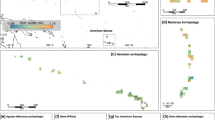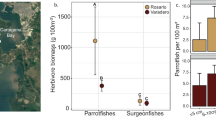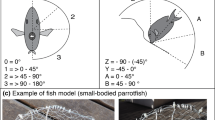Abstract
While climate change and associated increases in sea surface temperature and ocean acidification, are among the most important global stressors to coral reefs, overfishing and nutrient pollution are among the most significant local threats. Here we examined the independent and interactive effects of reduced grazing pressure and nutrient enrichment using settlement tiles on a coral-dominated reef via long-term manipulative experimentation. We found that unique assemblages developed in each treatment combination confirming that both nutrients and herbivores are important drivers of reef community structure. When herbivores were removed, fleshy algae dominated, while crustose coralline algae (CCA) and coral were more abundant when herbivores were present. The effects of fertilization varied depending on herbivore treatment; without herbivores fleshy algae increased in abundance and with herbivores, CCA increased. Coral recruits only persisted in treatments exposed to grazers. Herbivore removal resulted in rapid changes in community structure while there was a lag in response to fertilization. Lastly, re-exposure of communities to natural herbivore populations caused reversals in benthic community trajectories but the effects of fertilization remained for at least 2 months. These results suggest that increasing herbivore populations on degraded reefs may be an effective strategy for restoring ecosystem structure and function and in reversing coral–algal phase-shifts but that this strategy may be most effective in the absence of other confounding disturbances such as nutrient pollution.




Similar content being viewed by others
References
Adey WH, Vassar M (1975) Colonization, succession and growth rates of tropical crustose coralline algae (Rhodophyta, Cryptonemiales). Phycologia 14:55–69
Anderson MJ, Willis TJ (2003) Canonical analysis of principal coordinates: a useful method of constrained ordination for ecology. Ecology 84:511–525
Barott K, Smith J, Dinsdale E, Hatay M, Sandin S, Rohwer F (2009) Hyperspectral and physiological analyses of coral–algal interactions. PLoS ONE 4:e8043
Belliveau SA, Paul VJ (2002) Effects of herbivory and nutrients on the early colonization of crustose coralline and fleshy algae. Mar Ecol Prog Ser 232:105–114
Bellwood DR, Choat JH (1990) A functional analysis of grazing in Parrotfishes (Family Scaridae)—the ecological implications. Environ Biol Fish 28:189–214
Bellwood DR, Hoey AS, Choat JH (2003) Limited functional redundancy in high diversity systems: resilience and ecosystem function on coral reefs. Ecol Lett 6:281–285
Bellwood DR, Hughes TP, Folke C, Nystrom M (2004) Confronting the coral reef crisis. Nature 429:827–833
Bellwood DR, Hughes T, Connolly SR, Tanner JE (2005) Environmental and geometric constraints on Indo-Pacific coral reef biodiversity. Ecol Lett 8:643–651
Bellwood DR, Hughes TP, Hoey AS (2006) Sleeping functional group drives coral-reef recovery. Curr Biol 16:2434–2439
Birrell CL, McCook LJ, Willis BL, Diaz-Pulido GA (2008) Effects of benthic algae on the replenishment of corals and the implications for the resilience of coral reefs. Oceanogr Mar Biol Annu Rev 46:25–64
Box SJ, Mumby PJ (2007) Effect of macroalgal competition on growth and survival of juvenile Caribbean corals. Mar Ecol Prog Ser 342:139–149
Boyer KE, Fong P, Armitage AR, Cohen RA (2004) Elevated nutrient content of tropical macroalgae increases rates of herbivory in coral, seagrass, and mangrove habitats. Coral Reefs 23:530–538
Bruno JF, Sweatman H, Precht WF, Selig ER, Schutte VGW (2009) Assessing evidence of phase shifts from coral to macroalgal dominance on coral reefs. Ecology 90:1478–1484
Burkepile DE, Hay ME (2006) Herbivore vs. nutrient control of marine primary producers: context-dependent effects. Ecology 87:3128–3139
Burkepile DE, Hay ME (2008) Herbivore species richness and feeding complementarity affect community structure and function on a coral reef. Proc Natl Acad Sci USA 105:16201–16206
Burkepile DE, Hay ME (2009) Nutrient versus herbivore control of macroalgal community development and coral growth on a Caribbean reef. Mar Ecol Prog Ser 389:71–84
Carpenter RC (1986) Partitioning herbivory and its effects on coral-reef algal communities. Ecol Monogr 56:345–363
Carpenter RC, Edmunds PJ (2006) Local and regional scale recovery of Diadema promotes recruitment of scleractinian corals. Ecol Lett 9:268–277
Diaz-Pulido G, McCook LJ (2002) The fate of bleached corals: patterns and dynamics of algal recruitment. Mar Ecol Prog Ser 232:115–128
Diaz-Pulido G, McCook LJ (2003) Relative roles of herbivory and nutrients in the recruitment of coral-reef seaweeds. Ecology 84:2026–2033
Friedlander AM, DeMartini EE (2002) Contrasts in density, size, and biomass of reef fishes between the northwestern and the main Hawaiian Islands: the effects of fishing down apex predators. Mar Ecol Prog Ser 230:253–264
Grigg RW, Maragos JE (1974) Recolonization of hermatypic corals on submerged lava flows in Hawaii. Ecology 55:387–395
Grottoli AG, Rodrigues LJ, Palardy JE (2006) Heterotrophic plasticity and resilience in bleached corals. Nature 440:1186–1189
Harrington L, Fabricius K, De’ath G, Negri A (2004) Recognition and selection of settlement substrata determine post-settlement survival in corals. Ecology 85:3428–3437
Hatcher BG, Larkum AWD (1983) An experimental analysis of factors controlling the standing crop of the epilithic algal community on a coral reef. J Exp Mar Biol Ecol 69:61–84
Hixon MA, Brostoff WN (1985) Substrate characteristics, fish grazing and epibenthic reef assemblages off Hawaii. Bull Mar Sci 37:200–213
Hoey AS, Bellwood DR (2007) Cross-shelf variation in the role of parrotfishes on the Great Barrier Reef. Coral Reefs (online first)
Hughes TP (1994) Catastrophes, phase-shifts, and large-scale degradation of a Caribbean coral reef. Science 265:1547–1551
Hughes T, Szmant AM, Steneck R, Carpenter R, Miller S (1999) Algal blooms on coral reefs: what are the causes? Limnol Oceanogr 44:1583–1586
Hughes TP, Bellwood DR, Folke CS, McCook LJ, Pandolfi JM (2007a) No-take areas, herbivory and coral reef resilience. Trends Ecol Evol 22:1–3
Hughes TP, et al. (2007b) Phase shifts, herbivory, and the resilience of coral reefs to climate change. Curr Biol 17:360–365
Jennings S, Polunin NVC (1997) Impacts of predator depletion by fishing on the biomass and diversity of non-target reef fish communities. Coral Reefs 16:71–82
Jompa J, McCook LJ (2002) The effects of nutrients and herbivory on competition between a hard coral (Porites cylindrica) and a brown alga (Lobophora variegata). Limnol Oceanogr 47:527–534
Lapointe BE (1997) Nutrient thresholds for bottom-up control of macroalgal blooms on coral reefs in Jamaica and southeast Florida. Limnol Oceanogr 42:1119–1131
Lapointe BE (1999) Simultaneous top–down and bottom–up forces control macroalgal blooms on coral reefs—(reply to the comment by Hughes et al.). Limnol Oceanogr 44:1586–1592
Larned ST (1998) Nitrogen- versus phosphorus-limited growth and sources of nutrients for coral reef macroalgae. Mar Biol 132:409–421
Ledlie MH, et al. (2007) Phase shifts and the role of herbivory in the resilience of coral reefs. Coral Reefs 26:641–653
Leichter JJ, Stewart HL, Miller SL (2003) Episodic nutrient transport to Florida coral reefs. Limnol Oceanogr 48:1394–1407
Lewis SM (1986) The role of herbivorous fishes in the organization of a Caribbean reef community. Ecol Monogr 56:183–200
Littler MM, Littler DS (1984) Models of tropical reef biogenesis: the contribution of algae. In: Round FE, Chapman DJ (eds) Progress in phycological research, vol 3. Biopress, Bristol, pp 323–364
Littler MM, Littler DS, Titlyanov EA (1991) Comparisons of N-limited and P-limited productivity between high granitic Islands versus low carbonate atolls in the Seychelles Archipelago—a test of the relative dominance paradigm. Coral Reefs 10:199–209
Littler MM, Littler DS, Brooks BL (2006) Harmful algae on tropical coral reefs: bottom–up eutrophication and top–down herbivory. Harmful Algae 5:565–585
Mantyka CS, Bellwood DR (2007) Direct evaluation of macroalgal removal by herbivorous coral reef fishes. Coral Reefs 26:435–442
McClanahan TR, et al. (2003) Interaction between nutrients and herbivory in controlling algal communities and coral condition on Glover’s Reef, Belize. Mar Ecol Prog Ser 261:135–147
McCook LJ (1999) Macroalgae, nutrients and phase shifts on coral reefs: scientific issues and management consequences for the Great Barrier Reef. Coral Reefs 18:357–367
McCook LJ, Jompa J, Diaz-Pulido G (2001) Competition between corals and algae on coral reefs: a review of evidence and mechanisms. Coral Reefs 19:400–417
Miller MW, Hay ME, Miller SL, Malone D, Sotka EE, Szmant AM (1999) Effects of nutrients versus herbivores on reef algae: a new method for manipulating nutrients on coral reefs. Limnol Oceanogr 44:1847–1861
Mumby PJ, et al. (2007a) Trophic cascade facilitates coral recruitment in a marine reserve. Proc Natl Acad Sci USA 104:8362–8367
Mumby PJ, Hastings A, Edwards HJ (2007b) Thresholds and the resilience of Caribbean coral reefs. Nature 450:98–101
Nugues MM, Smith GW, Hooidonk RJ, Seabra MI, Bak RPM (2004) Algal contact as a trigger for coral disease. Ecol Lett 7:919–923
Nystrom M (2006) Redundancy and response diversity of functional groups: implications for the resilience of coral reefs. Ambio 35:30–35
Pandolfi JM, et al. (2003) Global trajectories of the long-term decline of coral reef ecosystems. Science 301:955–958
Pandolfi JM, et al. (2005) Are US coral reefs on the slippery slope to slime? Science 307:1725–1726
Smith JE, Smith CM, Hunter CL (2001) An experimental analysis of the effects of herbivory and nutrient enrichment on benthic community dynamics on a Hawaiian reef. Coral Reefs 19:332–342
Smith JE, Runcie JW, Smith CM (2005) Characterization of a large-scale ephemeral bloom of the green alga Cladophora sericea on the coral reefs of West Maui, Hawai’i. Mar Ecol Prog Ser 302:77–91
Smith JE, et al. (2006) Indirect effects of algae on coral: algae-mediated, microbe-induced coral mortality. Ecol Lett 9:835–845
Sotka EE, Hay ME (2009) Effects of herbivores, nutrient enrichment, and their interactions on macroalgal proliferation and coral growth. Coral Reefs 28:555–568
Thacker RW, Ginsburg DW, Paul VJ (2001) Effects of herbivore exclusion and nutrient enrichment on coral reef macroalgae and cyanobacteria. Coral Reefs 19:318–329
Vermeij MJA, Sandin SA (2008) Density-dependent settlement and mortality structure the earliest life phases of a coral population. Ecology 89:1994–2004
Worm B, Lotze HK (2006) Effects of eutrophication, grazing, and algal blooms on rocky shores. Limnol Oceanogr 51:569–579
Acknowledgments
This research was supported by the Hawai’i Coral Reef Initiative grant no. NA870A0381. We thank Dr David Bellwood and two anonymous reviewers for valuable comments that have helped to improve the manuscript. We would also like to thank Randall Kosaki, Brent Carman, William Walsh, Peter Hendricks, Robert Nishimoto, Lisa Wedding, Linda Preskitt, Anne Creason, Steven Cotton and Brian Zgliczynski for boat and dive support and help in the field.
Author information
Authors and Affiliations
Corresponding author
Additional information
Communicated by Geoffrey Trussell.
Electronic supplementary material
Below is the link to the electronic supplementary material.
Rights and permissions
About this article
Cite this article
Smith, J.E., Hunter, C.L. & Smith, C.M. The effects of top–down versus bottom–up control on benthic coral reef community structure. Oecologia 163, 497–507 (2010). https://doi.org/10.1007/s00442-009-1546-z
Received:
Accepted:
Published:
Issue Date:
DOI: https://doi.org/10.1007/s00442-009-1546-z




